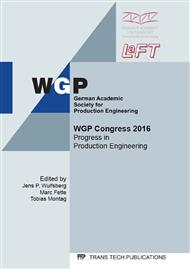p.67
p.75
p.83
p.91
p.99
p.107
p.115
p.123
p.133
Investigation of the Wear Behavior for Not Alloyed and Alloyed Hot Forming Tools
Abstract:
Over the last few years, hot stamping has been established as a suitable manufacturing process to produce high-strength structural parts. A tensile strength up to 1500 MPa and a high shape accuracy of the hot stamping parts are achievable. The hot forming tools are thereby stressed by varying thermo-mechanical loads resulting in increased surface wear. In order to reduce expensive and time consuming rework of the forming tools, an analysis of the tribological conditions is required. Purpose of this work is to increase the wear resistance of the tool surface and to investigate the wear behavior. In this regard, a laser alloying process is developed to influence the properties of the base material. Firstly, the alloying elements are selected and the element concentration is determined. Results for the composition of NiCrMo90 are presented, which is added by a wire fed laser alloying process unlike the previously used and already researched methods of powder bed fusion. This wire fed method is engineered to ensure a higher material utilization and to simplify the material feeding. After the alloying process the wear behavior of the alloyed surfaces are examined and compared to a not alloyed control group of pins under similar thermo-mechanical conditions.
Info:
Periodical:
Pages:
99-106
Citation:
Online since:
August 2016
Authors:
Keywords:
Price:
Сopyright:
© 2016 Trans Tech Publications Ltd. All Rights Reserved
Share:
Citation:


